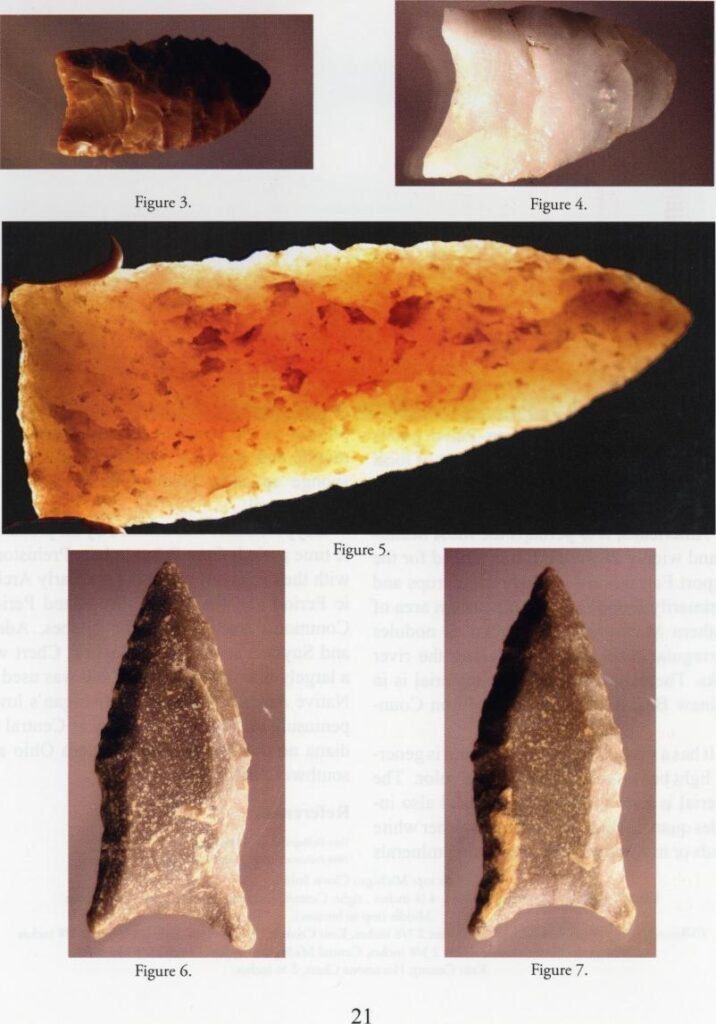by Cliff Jackson, Warrenton, North Carolina
Originally Published in the Central States Archaeological Journal, Vol.56, No.4, pg.200Originally Published in the Central States Archaeological Journal, Vol.57, No.1, pg.20

Figure 1. right Figure 2. left
Those elusive Paleolithic points that I hungrily read about in that old 1940s literature when I was a kid always seemed to elude me no matter how hard I looked and how many Archaic artifacts I found. The Folsom Site and the earliest occupants of North Carolina seemed to have little in common, if you looked at my artifact finds of my first twenty productive years. Triangles or “bird points” and Halifax “uglies” by the score, and even Early Archaic Palmers, Kirks and even Hardaways could be found, but fluted points just weren’t there on my sites for me.
Along about 1995, a few farmers bought some bigger bottom plows and I knew this would bring up a new layer beneath the old plow zone. On April 4, 1995, I found my first Paleo find (Figure 1.). This multi-colored quartz point surfaced in the plow’s throw, and was evidently much longer than its 2 1/4″ re-sharpened length would tell, judging by the width. It is broad and would be thick were it not for the flute on one side (Figure 2.). This Clovis is probably made from a locally found river cobble from the Roanoke River basin, which can be crystal clear, red, yellow, white, or a mixture of colors of quartz.
Many fields that year showed the black middens on the occupation sites, and eroded hilltops were red with fresh clay from the new plows. From one of those red hills came the little Clovis in Figure 3. Archaeologist Jack Hranicky has described this as a fine example of a “miniature Clovis” that he theorizes may have been a child’s toy. It measures 1 1/4″ long and is made of brown jasper.
In 1996, the plows unearthed a fine 5 1/2″ quartz Paleo knife (Figure 5.) from a riverside village site. Unfortunately, I was twenty feet away when my friend picked it up, and it took me many years to talk him into letting me buy it. This one is fine and thin, with the hafting area ground. Again, this was made from a local cobble of yellow quartz.
Also in 1996, I found an exceptional Cumberland (or Redstone?) in a field in Moore County NC (Figures 6. & 7. ) which was featured in my article in Indian Artifact Magazine Volume 17-4 1998 as “1996- The Year of the Paleo”. This fully fluted, waisted projectile is made of very high-grade rhyolite and is 2 1/8″ long. I had seen one very similar found on the same farm many years ago, and persistence in getting permission paid off in my first visit to the field. In the fall of that year, a multi-component site on another local swamp brought forth another fluted point (Figure 4.), this one made of local milky quartz with a deeply concave ground base. All of my fluted finds have been recorded in the North Carolina Fluted Point Survey, (started in 1971 by my fellow Warren County NC friend and archaeologist Phil H. Perkinson, and continued to this day by Rodney Peck of the PASNSCVA.)

The big bottom plows now stand unused, as no-till farming has eliminated most plowing in the attempt to stop soil erosion. I was fortunate to have had many years of field walking before this came about, since the past ten years or so have produced very few quality surface finds, and no Paleo to be found now that the rust is on the plow.”Used by Permission of the Author”
To learn more about or to join the Central States Archaeological Society, click here:CSASI.org
